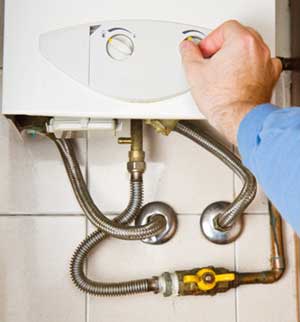
You may be under the impression that tankless water heaters do not require venting – but they do. In fact, once you’ve decided which tankless water heater to install, the decisions on how to vent it are the most important decisions you will make.
You see, indoor tankless units require two types of venting. One to pull in air from the outside and the second to release the hot exhaust gas outside. These factors determine where your tankless unit will be installed. Keep in mind though that tankless units can be installed inside the home and outside the home. The units that are outside do not require venting. Speak to your installer about your options.
Fortunately, you do have some options when it comes to venting.
Because tankless units use fans to blow out the exhaust, the venting can be through a roof or a side wall. This makes it easier if you are placing the tank on an interior wall in your home.
What Is The Difference Between Indoor and Outdoor Tankless Water Heaters?
Both indoor and outdoor units function basically the same way. The difference is in the venting – indoor units need to be vented, outdoor units do not. The outdoor units are made to withstand the elements (including freezing temperatures) but you do need to take extra precautions such as draining the unit during freezing weather.
The indoor tankless water heaters will require some extra ventilation piping that is not needed in the outdoor units and the indoor units also require the venting pipes to be attached to a drain, whereas the outdoor units do not need this.
What are the Benefits of a Tankless Water Heater?
One of the most touted benefits of a tankless water heater is that since the water is heated as needed (instead of being stored) there’s a constant supply of hot water. No chance of the hot water running out in the middle of your shower.
With a tankless unit you can fill up that large jacuzzi tub in your bathroom with no worries about running out of hot water for your dishwasher.
Some other benefits are:
- Tankless units can save you money in the long run. The U.S. Department of Energy has estimated that tankless units can be 24% – 34% more energy efficient in homes that use 41 gallons or less of hot water daily. Tankless units run at 90% – 98% efficiency. The standard water heater holds about 40 – 80 gallons of water and it keeps that water heated, waiting for you to use it. There’s a good amount of wasted energy in this type of system.
- If you need to maximize the space in your home, a tankless unit will certainly take up much less space than a conventional water heater.
- Tankless units are available as whole house units or small, point-of-use units for individual areas such as a sink or shower, etc.
- The lifespan of tankless units are almost double of a traditional water heater (20 plus years).
So, although the initial cost of a tankless unit is more – if you plan to stay in your home for the next 20 plus years, this type of water heater could save you money and time, when properly maintained.
What Is The Downside Of A Tankless Water Heater?
There are 3 “cons” of a tankless unit to consider.
- Because hot water is delivered directly on an as needed basis – the unit cannot produce hot water for multiple units at once. So, taking a hot shower AND running the washing machine may only give you lukewarm water. To avoid this you must purchase the proper size unit for your needs.
- The initial cost is higher than traditional water heaters.
- If you are switching from a traditional water heater to the tankless unit, there is a cost for retrofitting and installing the unit.
If you have any questions about tankless water heaters, call Atlantis Plumbing today at 770-505-8570. We are available 24 hours a day, 7 days a week.